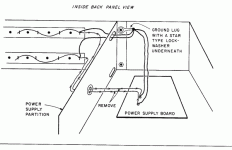Not going to make that much difference, although something like the Dale RN55's or CMF-55's will be a lot more stable. The RN55's were mil-spec so would have been pretty expensive at the time the DH-101 was sold, i.e. 1976.
Noise is specified as -86dB below 10mV in the manual (A-wtd).
I can't open PDF's at the moment -- it's an issue going around with Adobe and Windows XP. Bypassing the LM317/337 is easy -- but pretty soon you'll be gilding the lilly.
The Hafler RCA connectors need replacing after a while.
I was fortunate enough to live in Southern California at that time, surrounded by electronics surplus stores. Decent RN55s and RN60s were a penny to a nickle a piece, or less. Many stores had open "finger stock" so you could haul your meters into the store and make matched pairs on the spot.
The Audio Amateur had several articles over the years about modding the DH-101. Mine was pretty darned quiet and dynamic by the time I was done with it. It gave my Sumo Electra preamp (purchased many years later) a run for its money. I lent the DH-101 out a few years ago and haven't seen it since.
The Audio Amateur had several articles over the years about modding the DH-101. Mine was pretty darned quiet and dynamic by the time I was done with it. It gave my Sumo Electra preamp (purchased many years later) a run for its money. I lent the DH-101 out a few years ago and haven't seen it since.
There was a ground loop issue discussed in TAA 2/79. The fix is noted in the attached GIF.
The 4/1980 issue of TAA -- had some RIAA recommendations:
Q1 and Q2 -- use current gain matched units, change R10,R11 to 47R -- Hafler provided a kit for this purpose.
RIAA -- change C5 to 940uF, R9 to 90.9k -- change C7 to 0.024uF and add a 0.068uF from phono out to ground to reduce the rising HF response.
Coupling capacitors -- C2,8,11,20 -- were all bypassed with film caps. It was also suggested that a 50K 10-turn pot replace R6/8 so that DC offset on the phono stage be eliminated. In any event you'll have to adjust either R6 or R8 to minimize DC offset.
Obviously, the power supply issues aforementioned need addressing.
Attachments
The phono stage shouldn't be "that" noisy, and I wouldn't replace it -- why not try replacing the MC7818/MC7918 voltage regulators with LM317/337 -- and place 100uF cap between the adjust pin and ground. I think you can get almost an order of magnitude reduction in noise with this simple change. I would also replace the RCA female jacks with new ones. Clean switch contacts with isopropyl acohol, the high test version if you can get it.
After some serious listening tests, I would now recommend replacing the 7818/7918 with Linear Technology LT1963A and LT3015 adjustable regulators -- these can be connected with "Sense" (Kelvin) connection.
We might also want to consider replacing the power supply diodes (D1-D4) with soft recovery units, and/or install a snubber across the transformer secondary connections on PC-1. Replace C24-C27 with low-ESR versions of the same values and bypass each one with the largest polypropylene cap you can fit under the circuit board. Film caps to replace the cheap disc caps at C13 & C14.
Or just rip out PC-1 and replace it with a pair of Sulzer Op-Amp regulators (also featured in The Audio Amateur) and call it a day.
Or just rip out PC-1 and replace it with a pair of Sulzer Op-Amp regulators (also featured in The Audio Amateur) and call it a day.
I think you might be surprised by how good the Linear Tech regulators sound in comparison to the Sulzer.
Hey! Send me a few dozen to try out!
But seriously, I would hope that someone's come out with decent regulators for audio applications after 20+ years of R&D. I pulled up the specs on the LT1963A and I'm not finding the output impedance anywhere. It's an important spec and is one place where the Sulzer shined.
I think the Sulzer was TAA/1980 -- and it is quite a good regulator -- I have one with the "pre-regulator" and a bit beefier pass transistor.
I have them regulating the power to the front end of some of my amps. With a separate (much smaller) transformer I just leave the front end "On" all the time and power up the outputs when it's time to listen. No warm up time, as the outputs thermally stabilize pretty quickly.
- Status
- This old topic is closed. If you want to reopen this topic, contact a moderator using the "Report Post" button.
- Home
- Source & Line
- Analogue Source
- DH-101 with a noisy phono stage
